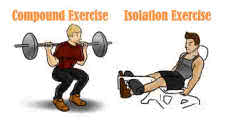Compound vs Isolation Training Exercises & Workouts to Build New Muscle

Make the Best of your Knowledge for Ultimate Results that Matter
Compound movements such as bench presses, squats, deadlifts, bent-over rows, behind-the-neck presses and power cleans are mass-builders. They involve several
muscle groups at the same time and don't really tend to focus totally on one specific muscle, hence the name compound. Isolation movements are meant to
isolate a single muscle group or a certain section of a muscle group. Examples are leg curls for hamstrings and dumbbell flys for chest.
Of course, if you know anything about exercise physiology, you'll understand that even the best isolation movement is never a total isolation exercise. For
cable crossovers you still stimulate your front delts, abs and biceps to some extent. Of course, with flat barbell presses you'll stimulate more front delt,
but you get the picture. As much as you think you're isolating a muscle, you can never totally isolate it. Ancillary muscles will always lend a hand. After
all, if you had to design the human body to be functional, why not allow several muscle groups to help move a bone, rather than only one?
I recommend compound movements if your mind-muscle connection is very advanced. In other words, if 1 tell you to do a barbell bench press or a barbell row,
and after one set you can feel your chest or lats tighten and pump up extremely quickly and massively, I'd say you have a superior mind-muscle connection. You
have the uncanny ability to maximize the amount of stress you can place on the target muscle with even a compound movement. As such, why not use compound
movements? If your chest blows right up after one set of bench presses, why do flys? It's not like the bench press isn't stimulating many fibers. You might
as well get the benefit of being able to use lots of weight and getting some delt and triceps growth as well. Kill more birds with one stone, in a sense.
Now, if you have a hard time pumping up certain body parts, you're going to have to learn the mind-muscle connection. You'll have to teach your body how to get
the most out of each rep. The easiest way to do that is to isolate as much as possible.
I suggest you begin all weak bodyparts with a mind-muscle link connection movement with at least 50 percent less weight than you would normally use. In other
words, if you fail at 15 reps on the dumbbell fly with 40 pounds, cut the weight to 20 pounds, and slow the movement down so that you still fail at 15 reps.
It's also a good idea to incorporate principles like pre-exhaust to activate more fibers. Make sure to use slightly higher reps to start with, and make sure to
perform them extra slow to really get the burn in the muscle.
For a weak chest, superset in a pre-exhaust fashion. An example would be to start your chest workout with 5 supersets of incline cable flys and pec-dec, each
exercise done till failure with at least 15 reps. This method will teach the pecs to contract against weight more efficiently. Finish the workout with 5 sets
of flat barbell bench presses for at least 20 reps per set to failure. Follow this routine for at least six weeks and I guarantee that by then you'll be able
to do low-rep benching and get a killer pump from even one set.
For those of you with other weak bodyparts, here are my recommendations. Stick with the same isolation superset, followed by a compound movement. For example,
if you have weak lats, you would superset Nautilus Pullovers with stiff-arm pulldowns or dumbbell pullovers, then finish off with barbell T-bar rows. A man
with weak biceps would superset one-arm cable curls with concentration curls, then finish with barbell curls. Weak quads get bombed with a leg-extension/sissy
squat superset, then blasted with good old squats. Weak delts? Punish them with a standing dumbbell lateral/side cable lateral superset, one arm at a time, then
finish the caps off with Arnold presses with dumbbells. You get the idea, so get to it and bring up those weak bodyparts!